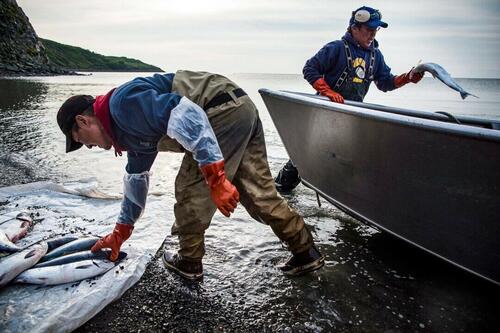
Federal Appeals Court Reverses Decision, Keeps Alaska Salmon Fishery Open
Authored by Tom Ozimek via The Epoch Times (emphasis ours),
A federal appeals court has reversed a lower court ruling that would have shut down the Southeast Alaska Chinook salmon fishery, a significant source of income for local fishermen, while keeping intact a program aimed at increasing prey for an endangered species of orcas.
 Two fishermen wash freshly caught salmon, in Nowtok, Alaska, on July 1, 2015. (Andrew Burton/Getty Images)
Two fishermen wash freshly caught salmon, in Nowtok, Alaska, on July 1, 2015. (Andrew Burton/Getty Images)The 9th U.S. Circuit Court of Appeals ruled on Aug. 16 that U.S. District Judge Richard Jones in Seattle had erred in 2023 when he invalidated a key permit, known as a “take statement,” issued by the U.S. National Marine Fisheries Service (NMFS).
This take statement, which specifically applied to the Southeast Alaska Chinook salmon fishery, authorized the summer and winter harvests of Chinook salmon, which are a critical food source for the endangered Southern Resident killer whales.
The appeals court’s decision allows the fishery to remain open while the NMFS revises its management plan, which both the lower court and the appeals court found contained some flaws.
The ruling is sure to be seen as a relief for Alaska’s fishing communities, which had argued that closing the fishery would have devastating economic consequences.
The Wild Fish Conservancy (WFC), which filed a lawsuit in 2020 challenging the NMFS’s authorization of the Southeast Alaska Chinook salmon fishery and praised the district court’s 2023 decision as a “major landmark victory,” did not respond to a request for comment on the appeals court’s decision.
However, WFC has previously indicated that it remains committed to advocating for the protection of endangered species.
Its its lawsuit, the conservation group argued that the fishery was depleting Chinook salmon populations, which in turn was threatening the survival of the Southern Resident killer whales, a critically endangered population with just 73 individuals remaining.
The Ruling
The 9th Circuit’s three-judge panel found that although the NMFS had made errors in its 2019 biological opinion, which assessed the impact of the fishery on endangered species, these errors were not significant enough to warrant shutting down the fishery entirely. The judges emphasized that the economic impact on Alaskan fishermen and their communities, including Alaska Natives, would be severe if the fishery were closed.
“The district court disregarded the likelihood that the take statement would be supported by better reasoning, and readopted, on remand,” the court wrote in its opinion. The judges also noted that even experts from the WFC conceded that vacating the take statement would lead to millions of dollars of losses for Alaska fishermen, while also acknowledging uncertainty about the fishery’s impact on whale populations.
The appeals court criticized the district court for insufficiently taking into consideration the “severe disruptive consequences” of vacating the take statement.
However, the appeals court found that the district court was correct in upholding the prey increase program after determining that vacating it would lead to environmental harms because the program provided an important source of prey for the killer whales, and that nixing the program would have disrupted unrelated fisheries and other federal actions.
In its lawsuit, the WFC had questioned the effectiveness of the prey increase program and the NMFS’ reliance on it in its management plan as a “mitigating” measure to offset negative impacts of reduced prey availability due to the fishery’s operations, though they did not specifically advocate for its termination.
WFC called the prey increase program “ill-defined” while arguing that various hatchery programs proposed as mitigation would “themselves have harmful impacts on wild salmon populations,” including threatened Chinook salmon, and that they “may result in greater harm than benefit.”
It’s unclear what action, if any, WFC intends to take in light of the appeals court’s ruling in the case.
Tyler Durden
Mon, 08/19/2024 – 06:30

 1 rok temu
1 rok temu












